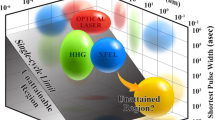Abstract
The Pohang Accelerator Laboratory X-ray Free Electron Laser (PAL-XFEL) has been successfully operating as a remarkably-stable XFEL facility in the world. The hard X-ray beamline, however, has only one undulator line (HX1) with a 26-mm undulator period for which the maximum undulator parameter K is 1.87. The lowest photon energy that can be generated from the HX1 with a maximum electron beam energy at PAL-XFEL (10.5 GeV) is about 14.65 keV. When a lower photon energy than that is required by the beamline users, the electron beam energy has to be decreased, which results in a decreased accessible FEL pulse energy. Therefore, a new hard X-ray undulator line (HX2) with a higher undulator parameter K is needed to make full use of the PAL-XFEL performance in the lower photon energies by increasing the resonant electron beam energy. The undulator period of the HX2 is decided as 35 mm by using Ming Xie’s fitting formula to estimate the performance of the HX2. FEL simulations with the GENESIS code are carried out to evaluate the performance of the HX2, including the effect of the post-saturation region. The undulator tapering configuration is optimized by maximizing the FEL intensity for each case. We show that the radiation power at the end of the HX2 can be increased up to 2.5 times higher than that of the HX1 over the entire target photon-energy range of the HX2 (2 ∼ 10 keV) by utilizing an undulator with a longer period and a higher undulator parameter K.
Similar content being viewed by others
References
P. Emma et al., Nat. Photonics 4, 641 (2010).
T. Ishikawa et al., Nat. Photonics 6, 540 (2012).
H-S. Kang et al., Nat. Photonics 11, 708 (2017).
M. Altarelli, Nucl. Instrum. Methods Phys. Res. B 269, 2845 (2011).
C. J. Milne et al., Appl. Sci. 7, 720 (2017).
I. S. Ko et al., Appl. Sci. 7, 479 (2017).
H-S. Kang et al., J. Synchrotron Radiat. 26, 1127 (2019).
K. H. Kim et al., Science 358, 1589 (2017).
S. H. Park et al., Sci. Rep. 9, 16316 (2019).
J-H. Park et al., Int. J. Mol. Sci. 20, 1943 (2019).
A. S. M. Ismail et al., Phys. Chem. Chem. Phys. 22, 2685 (2020).
Z. Huang and K-J. Kim, Phys. Rev. ST Accel. Beams 10, 034801 (2007).
M. Xie, in Proceedings of the 1995 Particle Accelerator Conference (Dallas, USA, 1995), p. 183.
M. Xie, Nucl. Instrum. Methods Phys. Res. A 445, 59 (2000).
S. Reiche, Nucl. Instrum. Methods Phys. Res. A 429, 243 (1999).
N. M. Kroll, P. L. Morton and M. N. Rosenbluth, IEEE J. Quantum Electron. 17, 1436 (1981).
Y. Jiao et al., Phys. Rev. ST Accel. Beams 15, 050704 (2012).
A. Mak, F. Curbis and S. Werin, Phys. Rev. ST Accel. Beams 18, 040702 (2015).
D-E. Kim et al., J. Korean Phys. Soc. 71, 744 (2017).
C-K. Min et al., J. Synchrotron Radiat. 26, 1101 (2019).
Y. W. Parc, C. H. Shim and D. E. Kim, Appl. Sci. 8, 1588 (2018).
H-S. Kang and I. S. Ko, Nat. Photonics 14, 7 (2020).
Acknowledgments
This research was supported by the Basic Science Research Program through the National Research Foundation of Korea (NRF) funded by the Ministry of Education (Grant No. NRF-2019R1I1A1A01041573).
Author information
Authors and Affiliations
Corresponding author
Rights and permissions
About this article
Cite this article
Shim, C.H., Kang, HS. FEL Simulation of New Hard X-ray Undulator Line at PAL-XFEL. J. Korean Phys. Soc. 77, 429–437 (2020). https://doi.org/10.3938/jkps.77.429
Received:
Revised:
Accepted:
Published:
Issue Date:
DOI: https://doi.org/10.3938/jkps.77.429



